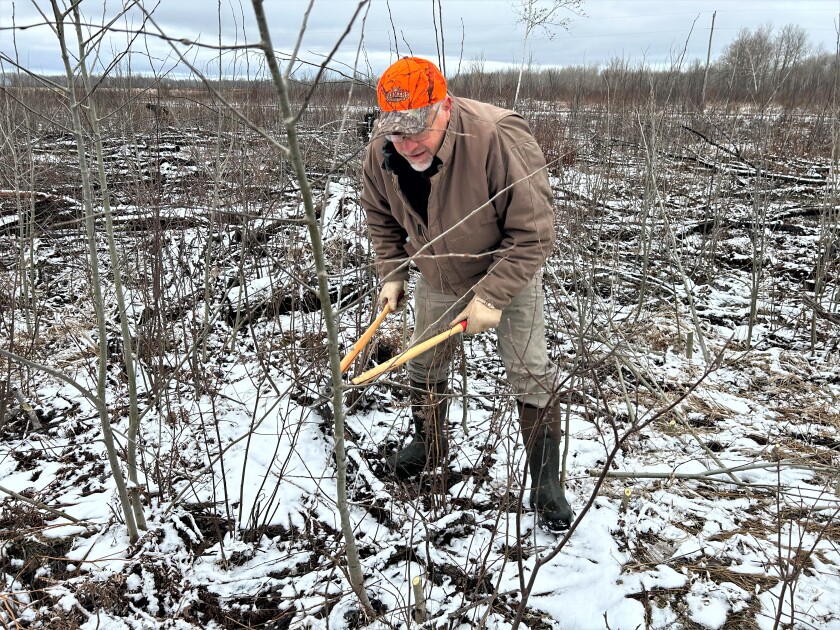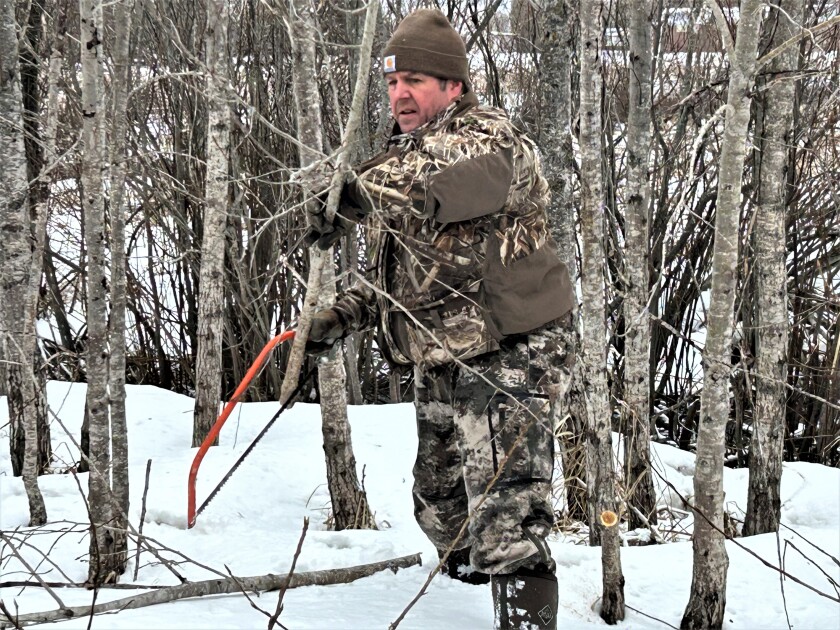KETTLE RIVER, Minn. — This should be the time of year when sharp-tailed grouse do their dancing, the territorial mating ritual when males square off to bluff fight and females gather to watch.
To the winners of this chest-puffing, wing-spreading display of hormones goes the right to court, mate and pass on their progeny.
ADVERTISEMENT
But that’s not happening at the Firebird Wildlife Management Area in northwestern Carlton County anymore because the sharptails are all gone, echoing a problem across the region.

“This should be a good spot. There have traditionally always been leks (dancing grounds) on this site, and several more within a couple miles around here. But not anymore,” said Chris Balzer, area wildlife manager for the Minnesota Department of Natural Resources. “The numbers just kept going down until there weren’t any left.”
There are so many people building out in the country now. Everybody wants their acre or 10 acres or 40 acres of land to put their house or cabin on. Most of what’s happening to this landscape now is non-compatible with sharptail habitat.
But on a cold and windy Earth Day last week, two dozen volunteers showed up at the Firebird area to try and keep the habitat suitable for sharptails, hoping the birds will come back. They wore rubber boots and used saws and axes and lopping shears to beat back the trees and brush creeping out into the open fields. They included members of the Minnesota Sharp-tailed Grouse Society, wildlife management students from Vermilion Community College in Ely, members of the Rush City High �������� trap shooting team and more.

“You have to try. It’s worth the effort,” said Hayley Darke, a Vermilion Community College student.
Darke was busy with lopping shears cutting small aspen or popple trees that had sprouted since the last effort here. The Firebird area — 726 acres, parts of three former farms — was purchased by the DNR a few years ago with conservation money from the state’s legacy sales tax and help from several conservation groups. Since then, several habitat projects have been conducted, with more on the way, to mechanically remove brush by mowing and chopping and by lighting intentional fires, called controlled burns, used to make room for native wildflowers that were planted.

“You have to keep at it or the forest reclaims it,” said Marshall Deters, a member of the sharptail association who coordinated the Saturday work day. “This is a continual process.”
Deters noted that all of the volunteer’s hours of work and travel count as matching funds to help secure state grants.
ADVERTISEMENT
A slow slide to zero
The decline of sharptails in east-central Minnesota was gradual for decades, but, for some reason, sped up over the past 10 years, so much so that the DNR canceled the sharptail hunting season here in 2021. It’s not likely to ever return.
In the past, DNR surveys regularly spotted six to 12 males dancing at this site each spring, with a recent peak of 15 males in 2011. But by 2020, that number had dropped to four. In 2021, there was just one, lonely male. In 2022, there were none, and they haven’t returned so far this spring.

It’s pretty much the same story at many former sharptail hotspots across eastern Minnesota, from Chisago, Pine and Kanabec counties in the south through Carlton, Aitkin, St. Louis and even Koochiching counties in the north, sharptails are disappearing. Only in northwestern counties are the birds holding their own in Minnesota.
“Lately it’s just been bad news in the east-central area,” said Dave Pauly, retired DNR wildlife manager and president and charter member of the Minnesota Sharp-tailed Grouse Society that formed 36 years ago. Perhaps no one has worked harder than Pauly to bring the birds back.
Pauly noted that intensive efforts to restore habitat are helping in some areas, Like Minnesota's St. Croix State Park and Wisconsin's Namekagon Barrens. But across much of the Northland the story is the same: fewer sharptails than ever before.
ADVERTISEMENT
If you clear it, they will come
The reasons behind the decline are many, but most center around habitat. Sharptails historically depended on wildfires to open up forested land and create their favored, wide-open habitat — so much so that the Indigenous people here called them the "firebird."
The massive amount of logging and huge fires of the late 1800s and early 1900s created perfect sharptail habitat. Early European settlers described sharptails flying in such large numbers that they sometimes blocked out the sun.

But as the forest grew back, and as wildfires became far less frequent, sharptail habitat declined. For most of the 20th century, many small farms — with open grazing land and hay fields — provided a decent substitute. But as many former farm fields are now transformed into recreational or residential properties, fewer large open areas exist.
People who buy land generally want trees, not fields, Pauly noted, adding to the problem. People also bring pets, including roaming cats, which kill sharptails. Other predators include hawks and small mammals like skunks and raccoons that raid nests. Having lots of people around, and vehicle traffic, doesn’t help.
“There are so many people building out in the country now. Everybody wants their acre or 10 acres or 40 acres of land to put their house or cabin on,” Pauly noted. “Most of what’s happening to this landscape now is non-compatible with sharptail habitat.”
Part of the problem is the sheer size of open land that sharptails favor. Firebird looks like a big, open area to the untrained eye. But 700 acres still isn’t big enough for these birds.
“Some research suggests that sharp-tailed grouse need 30,000-acre complexes of open habitat to maintain their populations over time,” Balzer said.
ADVERTISEMENT

Trying to keep that much nearly contiguous land open in the Northland is getting much more difficult. Wildfires are usually snuffed before they get anywhere near that size. And the appetite for controlled fires is limited. Climate change, with increased flooding, also is keeping the land too wet for the birds, at least between droughts.
Still, Pauly and Balzer both remain hopeful, and thankful for volunteers willing to put in the effort and for Minnesota taxpayers willing to foot the bill to buy and preserve habitat.
“It’s not just grouse but all sorts of insects and birds and mammals and herps (amphibians like salamanders) that benefit from this work,” Pauly noted.
If there are a few sharptails left around, the biologists say, they will find the best places to live.
“Sharp-tailed grouse are very mobile and adapted to finding new areas with suitable habitat, such as after large wildfires,” Balzer added. “If the habitat is good enough to support birds, they should be able to find it.”











